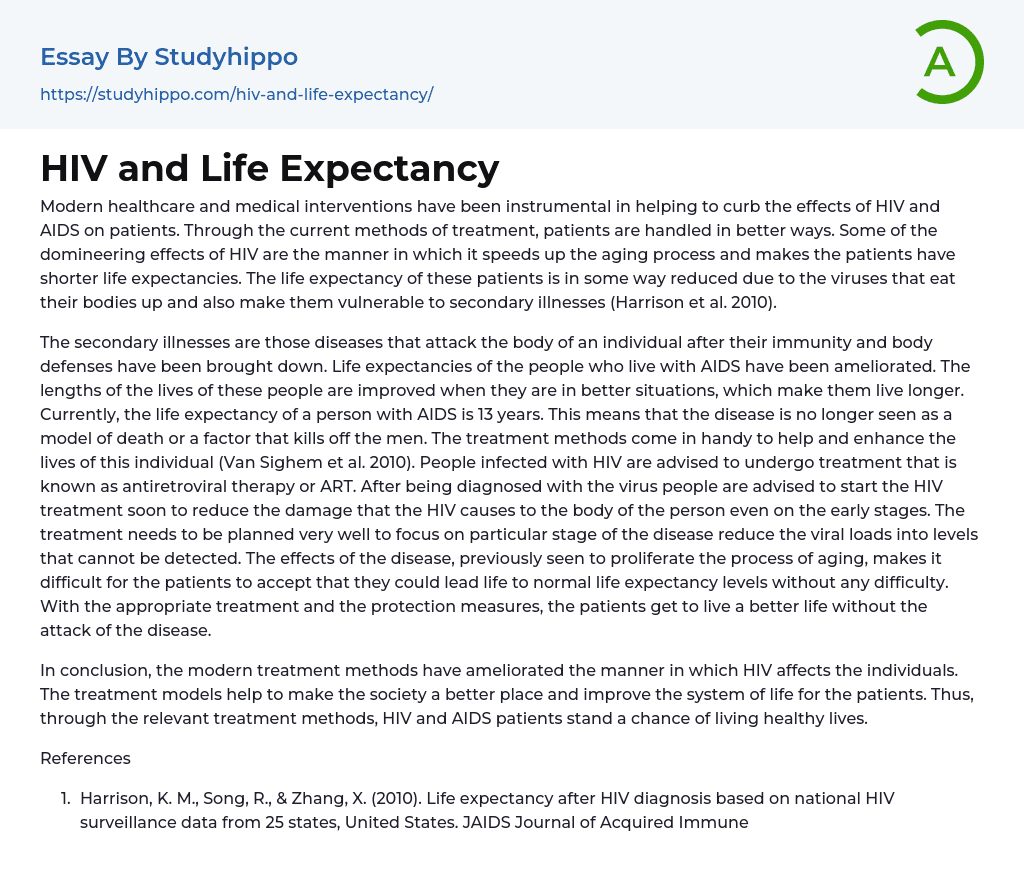Modern healthcare and medical interventions have been instrumental in helping to curb the effects of HIV and AIDS on patients. Through the current methods of treatment, patients are handled in better ways. Some of the domineering effects of HIV are the manner in which it speeds up the aging process and makes the patients have shorter life expectancies. The life expectancy of these patients is in some way reduced due to the viruses that eat their bodies up and also make them vulnerable to secondary illnesses (Harrison et al. 2010).
The secondary illnesses are those diseases that attack the body of an individual after their immunity and body defenses have been brought down. Life expectancies of the people who live with AIDS have been ameliorated. The lengths of the lives of thes
...e people are improved when they are in better situations, which make them live longer. Currently, the life expectancy of a person with AIDS is 13 years. This means that the disease is no longer seen as a model of death or a factor that kills off the men. The treatment methods come in handy to help and enhance the lives of this individual (Van Sighem et al. 2010). People infected with HIV are advised to undergo treatment that is known as antiretroviral therapy or ART. After being diagnosed with the virus people are advised to start the HIV treatment soon to reduce the damage that the HIV causes to the body of the person even on the early stages. The treatment needs to be planned very well to focus on particular stage of the disease reduce the viral loads into levels that cannot be
detected. The effects of the disease, previously seen to proliferate the process of aging, makes it difficult for the patients to accept that they could lead life to normal life expectancy levels without any difficulty. With the appropriate treatment and the protection measures, the patients get to live a better life without the attack of the disease.
In conclusion, the modern treatment methods have ameliorated the manner in which HIV affects the individuals. The treatment models help to make the society a better place and improve the system of life for the patients. Thus, through the relevant treatment methods, HIV and AIDS patients stand a chance of living healthy lives.
References
- Harrison, K. M., Song, R., & Zhang, X. (2010). Life expectancy after HIV diagnosis based on national HIV surveillance data from 25 states, United States. JAIDS Journal of Acquired Immune Deficiency Syndromes, 53(1), 124-130.
- van Sighem, A., Gras, L., Reiss, P., Brinkman, K., & de Wolf, F. (2010). Life expectancy of recently diagnosed asymptomatic HIV-infected patients approaches that of uninfected individuals. Aids, 24(10), 1527-1535.
- Birth Control essays
- Drug Addiction essays
- Eating Disorders essays
- Epidemiology essays
- Hiv essays
- Hygiene essays
- Obesity essays
- Social Care essays
- Teenage Pregnancy essays
- alternative medicine essays
- Aspirin essays
- Cannabis essays
- Cardiology essays
- Cloning essays
- Dentist essays
- drugs essays
- Hemoglobin essays
- Medical essays
- Medical Ethics essays
- Organ Donation essays
- Patient essays
- Pharmacology essays
- Plastic Surgery essays
- Surgery essays
- Therapy essays
- Vaccines essays




